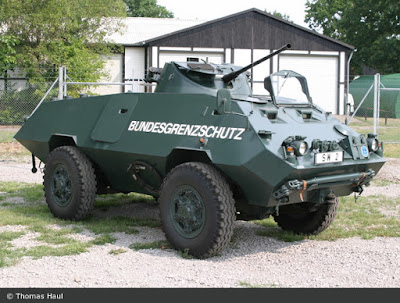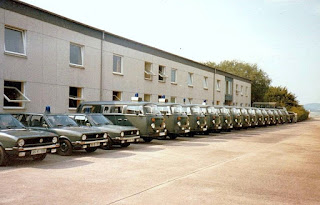Bundesgrenzschutz (BGS)
post 1976 shoulder badge
My units basically will be built for my games set between 1976 and 1987. I will use them in the role of border guards, rail, port, coast guard, airports, foreign embassies, nuclear plant protection and air security. I will use them as first line of defence for the initial WARPAC assaults, scenario specific special forces strikes on airports, port facilities, foreign embassy guards and as backup units for the Bundeswehr. I could also use the the GSG-9 for the 1977 Mogadishu Somalia operation, or regular BGS for UN operations in Namibia in 1989.
Organisation and Equipment
Two border guard groups (GSG) were subordinate to each GSK.
The GSK South GSG 1 and 2, the GSK Middle GSG 3 and 4, the GSK North GSG 5 and 6 and the GSK Coast GSG 7 and See (coast guard). Each GSG (except for the GSG See) consisted of three departments (GSA), each department of four hundred. The GSG See consisted of the Maritime Border Protection Associations (SGV) I and II. In 1955, a helicopter flight readiness was set up in Bonn-Hangelar.
Uniforms
In 1976 a the new federal / state uniform police uniform (moss green jacket, beige pants). In the BGS, only the members of the individual border protection service at airports, port facilities and border checkpoints are equipped with beige trousers. BGS members with combatant status receive moss-green trousers. The service field uniform was reed green, beret or service cap, or but field units did wear camouflage fatigues based on the sumpfmuster camouflage. The military rank structure similar to that of the Bundeswehr was replaced in 1976 by civil service-type personnel grades with a Police ranking structure.
The latest photo I have found for use of the camouflage uniforms
MG1 machine gun, entering service as rechambered MG42 to 7.62 Nato round, it seen service as the primary BSG machine gun until the mid eighties when it was replaced by the MG3.
Field dress green uniform, note the black post 1975 arm badge and shoulder waffenfarbe, and like all greens different shades of green, circa 1990.
Full dress service dress, often seen in airports note the collar tabs, post 1976 yellow shirt and green tie.
1987 Service Uniform, a photo when women were allowed to enter the BGS
M35-53 stahlhelm Helmet in service until mid 1990. The troops liked the helmet as the nervous east germans could identify the BGS troops on patrol easily.
The BGS’s cloth hat, the Bergmutze M51, was essentially the same as the Einheitsmutze M43 cap of WWII.
BGS beret earlly pattern
BGS Beret late pattern
Camouflage clothing
Post 1963, the sumpfmuster camouflage was made for several of the BGS items of clothing
- Triangular tent track
- Tent equipment pocket
- Helmet camouflage cover
- Field cap
- Camouflage jacket
- Camouflage pants
- parka, reversible snow.
A pre 1963 Sumpfmuster camouflage jacket, in service until 1985, note the badge is pre 1975 green.
Note the post 1963 sumpfmuster has lost its rain lines and the brown dominates the pattern, Gewehr G1, shoulder boards and steel helmet, photo 1978
Weapons
Esperanza 81mm mortar complete with ECIA ammunition crate. The red/yellow helmet bands were used by the BGS when exercising with live ammo.
FN G1 7.62 rifle
G3a3 7.62 rifle
panzerabwehr gerat 101mm
K9 units
I will have one K9 ( dog section of four figs ) for protection units, mostly because I have some old airfix ones!Vehicles
MOWAG MR 8 (WOTAN)
a interesting photo from circa 1973, note the panzer wrap jacket
The SW1
MOWAG MR 8 basic vehicle was not armed and had a small observation turret, IN 1963 the BGS received the first models as unarmed armoured cars with two crew and four passengers.
The MR8- SW 2
MOWAG MR 8 SW2 was armed with either a G3 machine gun or a 20mm cannon armoured car with two crewTM170 (SW 4)
Based on the tested Unimog chassis, 80 of these vehicles came into service from 1983 replacing the MOWAG series 1 and 2. with two crew and capacity for 10 men, it was fitted with NBC and run flat tyres. Armed with a pintle mounted MG3 or a turret with twin MG3 or a turret with a 20mm cannon.
Soft skins
DKW Munga 1977-1985
Florian WF Man Ktw ambulance
VW T3 Ambulance
VW T3 bus
VW 181
VW GTI
motorcycle
Mercedes Benz G230 W460 4x4 car entered service 1979-92
VW Passat
Unimog FuKw E communications truck
Mercedes LA 911 Truck 1961-1984
Air support
Broken into five regions North, South, centre, east and west. None of the helicopters were armed.SA 313/318 Alouette II helicopter (1964 until 2007)
13 x Bell UH-1D Heuy (1976-2001) and 10 x Bell 212 helicopter (1974-2012)
25 x SA330/AS332 Puma helicopter (1973 -2008)














































No comments:
Post a Comment